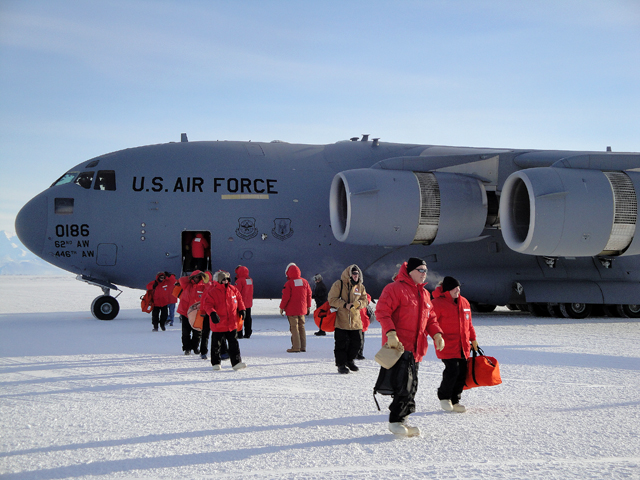Suddenly summerMain field season under way as planes bring in hundreds of people to McMurdoPosted October 16, 2009
Some waiting crowd members held welcome signs, but not ones you’d see at an airport. An electrician lofted a light bulb in the air, like an idea. The janitors created a paper gauntlet of names scrawled on loose leaf notebook paper. And — no surprise — a crafty, yellow wooden sign greeted new McMurdo Station All waited, bracing for the influx of mainbody personnel to gush forth from their orientation arrival briefing and flood the hallway with big red jackets and new or familiar faces. Mainbody flights started arriving Oct. 3 (local time) and will continue throughout the Antarctic summer. The term “mainbody” refers to the summer migration of National Science Foundation Compared to McMurdo’s winter population of 153 and the Winfly jump to 476 that arrived five weeks ago, mainbody exponentially increases the population and pumps up the pace of station life. “It goes from serene and familiar to mayhem and unfamiliar,” said heavy equipment operator Stephen Bennett. “We become an upside-down anthill … an upside-down red anthill.”
Kathleen Flanagan, who tracks the population on the Ice for the U.S. Antarctic Program “The official population cap is 1,100,” she said in an e-mail. “The last two weeks of January will see the most people.” Mainbody’s shot in the arm affects everything from where people work to what they eat. Folks prepare and pack out for field camps. The Recreation board fills up with club notices and activities. Flights to and from the Ice arrive regularly, resulting in mail delivery and “freshies” — code for the highly prized fresh food and vegetables. Mainbody personnel go through five cases of Cheerios a week, 3,500 cookies and require 90 pounds of bread for their dinnertime compared to less than half that at Winfly, said McMurdo Station executive chef Jennifer Jabs. In general, it’s a lot busier and the dining room is packed at mealtimes, Jabs said in an e-mail. Power loads also increase by about 300 kilowatts during the summer due to what’s needed to support the population and the projects, said Adam Fontana, Power and Water supervisor. “More people equal more lights, TVs, and more buildings open. Also work centers will be open longer and operate on separate shifts,” Fontana said. And while summer’s warm temperatures bring relief in terms of decreased equipment and energy needed for heating, Fontana suggested using natural instead of electric lighting and asked folks to limit long showers with running water. After mainbody concludes in February, the tone of the station will change again, said Jon Tate, baker’s assistant in the McMurdo kitchen. “The day everyone flew out, the station immediately felt different and a lot calmer,” Tate said. And while it seems busy as everyone settles in, mainbody’s energy is a net positive, Bennett said. “It’s good,” he said. “It fills us out.”
|



For USAP Participants |
For The Public |
For Researchers and EducatorsContact UsU.S. National Science FoundationOffice of Polar Programs Geosciences Directorate 2415 Eisenhower Avenue, Suite W7100 Alexandria, VA 22314 Sign up for the NSF Office of Polar Programs newsletter and events. Feedback Form |



